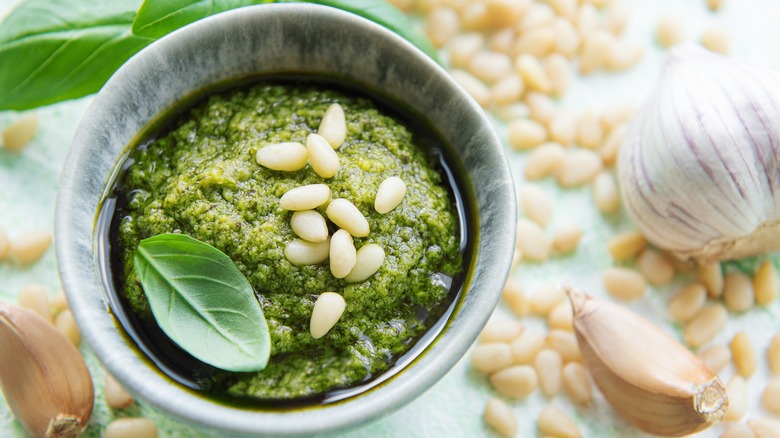The Simple Method For Keeping Your Homemade Pesto Green
Nothing compares to a fresh serving of pasta — whether you prefer bow-tie, penne, rigatoni, or gimelli — coated in a bright green, garlicky yet nutty pesto sauce. You want nothing more than to make a big batch to eat throughout the week, but that would require your pesto to maintain its color, which can be more challenging than you may think. Similar to the case of guacamole, another tasty green mixture infamous for browning, the culprit in this offense is a chemical reaction known as oxidation. According to Kemi, oxidation deteriorates the quality of your food, particularly the color and taste of it, and occurs when your ingredients are exposed to air.
Oxygen — am I right? Sure, it allows you to breathe. But does it really have to deteriorate your food in the process? Even though there isn't anything you can do about the oxygen in the air, there are a few steps you can take to ensure your pesto stays green. But although you could blanch your basil leaves, there's an even better trick to maintaining their color (via Food and Style).
Chill your tools
Paolo Laboa, the winner of the 2008 World Pest Championship (via Press Herald), knows a thing or two about the sauce — and how to keep it green. In addition to his notes on what type of basil you should use and the right amount of garlic, Laboa made a point that, when making a big batch of his famous family recipe, he puts his blender in the fridge for a few minutes. While it may sound strange, the "Pesto King" isn't the only one chilling the tools before making the sauce. Italian Michelin-starred chef, Mauro Ricciardi, does the same thing but with a marble mortar and pestle (via Kitchn). During the crushing of the pine nuts for the pesto, Ricciardi ensures his mortar is very cold and makes a point to use a marble mortar because it maintains the cold temperature well.
To chill your tools at home, Disgraces On The Menu says you can place your mortar or blender inside your refrigerator or freezer for a few minutes while you get your ingredients together. In doing so, you'll counter any of the heat produced either by the blades in your blender, or the friction of your mortar and pestle that further deteriorates the color and flavor of your pesto. Then, when you're done making your sauce, use another easy trick to keep your pesto from turning brown and top it off with a generous amount of olive oil before storing it away.

